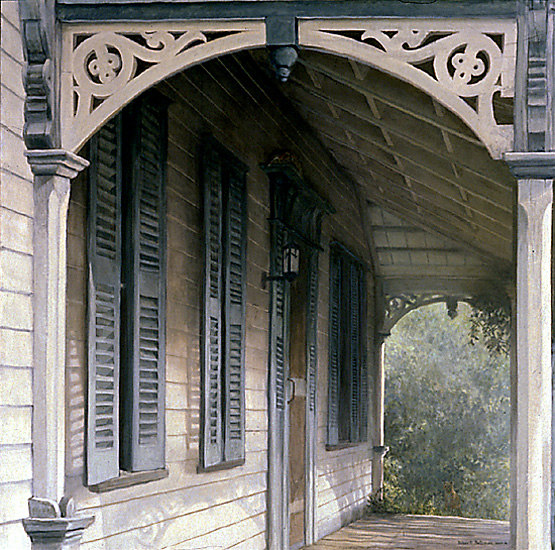- Lucas Porch
- (scroll down for description)

-
-
-
-
-
- 36” x 36”, acrylic on canvas, 2000
-
- Lucas Farm was established in the 19th Century on good land near the school where I was teaching in the 1970s. By the time I discovered it, its fate was sealed. Urban sprawl had made farming an untenable land use. The Lucas family kindly allowed me to take my art students onto the property on sketching trips. Although its old charm remained, the Victorian house was being taken over by a tangle of nature. To me the cracks and peeling paint added the dignity of age to the sprightly and lyrical architectural details. These details speak to me of an exuberant and inventive period in our history.
-
- A family of robins is in residence above the no-longer-used front door. Lucas Farm also forms part of the territory of a house cat. This efficient hunter will be very interested in the baby robins if they should flutter within reach. Even well fed house cats kill millions of birds each year. They are programmed predators. The message in this painting is please control your cat. It certainly would be better for the birds.
-
- BACKGROUND
- The mid 1800’s represented a turning point in Canadian agriculture. Ontario farmers were able to sell their wheat crops for record-high prices. The American civil war created a demand for food of all kinds, and the wheat farmers were able to diversify into fruits, vegetables, hogs and cattle. The Douglass-Lucas farmhouse is a demonstration of Ontario’s newfound prosperity.
-
- Located on a 100-acre parcel in Halton County, near Burlington, the house was built by Thomas Douglass. Typical of the era, the house was built in the Georgian Style-symmetrical and having a center hall plan. Sold to John Lucas in 1856, the house was occupied by generations of Lucas family farmers for 117 years. It was then purchased in 1973 by Stelco Steel Canada who donated it to the Country Heritage Park Museum in Milton.

